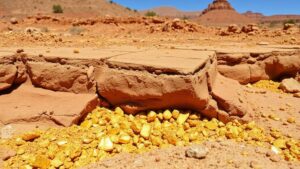The Role of the Early Apache and Spanish Miners in Discovering Rich Deposits
The Role of the Early Apache and Spanish Miners in Discovering Rich Deposits
The exploration and extraction of mineral resources in the Americas have profound historical significance, particularly involving the contributions of early Apache and Spanish miners. This article examines their roles in discovering rich deposits, the methods they employed, and the impact of their endeavors on regional development and economies.
The Apache: Indigenous Knowledge and Resourcefulness
The Apache tribes, comprising various groups such as the Western Apache and the Chiricahua Apache, utilized their intimate knowledge of the land to locate natural resources. Their understanding of geology, horticulture, and ecology allowed them to exploit mineral deposits long before European settlers arrived.
- Traditional Mining Practices: Apache miners engaged in surface mining techniques, often digging shallow pits to extract minerals like turquoise, which held cultural significance and value.
- Geographical Awareness: The Apache tribes had a vast territorial awareness and were well-acquainted with the locations of various natural resources, leading to strategic mining practices.
For example, the Chiricahua Apache utilized natural rock outcrops as indicators of potentially valuable mineral deposits. r traditional knowledge proved beneficial in identifying areas rich in gold and silver.
The Spanish Influence: Methods and Impact
Arriving in the Americas in the 16th century, Spanish explorers and miners brought with them advanced mining techniques and European methods, fundamentally altering the landscape of resource extraction.
- Use of Technology: The Spanish introduced hydraulic mining techniques, which used water to excavate minerals, significantly increasing the efficiency of gold and silver extraction.
- Mining Legislation: Spanish laws, such as the “Mita” system, allowed for organized labor and exploitation of indigenous populations, reflecting both the cultural and economic impacts of mining.
For example, the discovery of silver in areas like Potosí (modern-day Bolivia) and Zacatecas (Mexico) showcased the Spanish ability to locate and exploit vast mineral deposits. This not only enriched the Spanish crown but also set a precedent for future mining operations in the Americas.
Case Studies: Rich Deposits and Their Discovery
The juxtaposition of Apache and Spanish mining endeavors illustrates the diverse methods and outcomes associated with mineral exploration. A notable case is the Silver Mining in the Southwest.
- Santa Rita del Cobre: This site in present-day New Mexico was frequently mined by both Apache tribes and Spanish settlers, indicating a rich vein of copper and silver. techniques used varied significantly, with indigenous practices focusing on surface-level mining while Spanish miners delved deeper.
- Chihuahua Silver Mines: The Spanish exploitation of the Chihuahua region in the 18th century resulted in the extraction of millions of pesos worth of silver. The collaboration and conflicts with Apache miners to access these rich deposits shaped the mining culture in the region.
The success of these mining operations not only influenced local economies but also significantly contributed to global trade networks, further intensifying European interests in the Americas.
Lasting Impact and Legacy
The involvement of Apache and Spanish miners set the stage for a complex history of resource extraction that shaped cultural exchanges and economic relationships. Their efforts led to the establishment of towns, infrastructure development, and significant contributions to both indigenous and colonial economies.
- Economic Development: Mining led to the growth of local economies, as towns formed around mining operations, providing jobs and services.
- Cultural Exchanges: The interactions between Apache miners and Spanish settlers facilitated a blend of cultures, influencing mining techniques and regional dynamics.
To wrap up, the collaborative yet often contentious relationship between early Apache and Spanish miners in discovering rich mineral deposits highlights a pivotal chapter in the history of resource extraction. r diverse approaches to mining not only led to significant economic developments but also shaped the cultural landscapes of the American Southwest, the effects of which are still felt today.
Actionable Takeaways
- Understanding the historical context of Apache and Spanish mining can provide critical insights for modern mining practices and policies.
- Indigenous knowledge systems offer valuable perspectives on sustainable resource extraction methods.
- Recognizing the cultural significance of mineral deposits can lead to more equitable partnerships in contemporary mining efforts.



